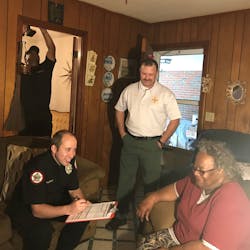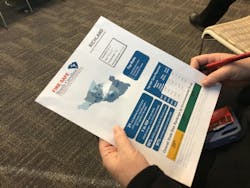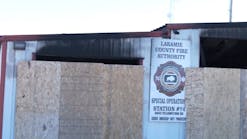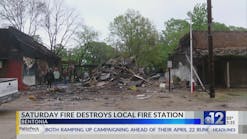Putting “Community” in Community Risk Reduction
Historically, South Carolina was one of the states that had the highest number of fire fatalities per capita. Many years, the state was among the five worst in the country in this regard.
Over the years, various programs and initiatives were used to curb this trend, but minimal change was brought about. However, the summer of 2017 saw the launch of Fire Safe South Carolina. Rather than just another program, it was deemed a vision for the future of fire prevention in the state.
After 18 months of implementation, South Carolina has seen great success. In 2019, fire fatalities in the state decreased 28 percent (a 14 percent decrease from its five-year average).
How is Fire Safe South Carolina different from the previous programs? What are the secrets to its apparent success?
Four-part harmony
Fire Safe South Carolina (firesafe.sc.gov) was founded by fire and nonfire service partners to facilitate collaborative action for fire prevention. Assistant State Fire Marshal Nathan Ellis fostered its development and progress. Support for his efforts is provided by the community risk reduction (CRR) team of the South Carolina Office of State Fire Marshal (OSFM). The program’s mission states, “Fire Safe South Carolina will unite fire service organizations to engage influential community stakeholders; together, we will support local fire departments to serve their citizens through strategic community risk reduction programs.”
In short, the program unites, engages, supports and serves. It seeks to accomplish the following goals and objectives:
- Reduce annual home fires in South Carolina, decreasing risks for residents and firefighters; a method for accomplishing this is increasing fire service CRR participation through increased training, partnerships and opportunities
- Provide consistent fire prevention messages across the state, including recruitment of community stakeholders and the utilization of various forms of mass communication, such as social media, to promote fire prevention messages
- Provide data-driven resources to enhance programming, including the: identification of residents who are at the highest risk in participating communities; targeting home visits to those areas; and providing for the procurement and distribution of smoke alarms
- Improve fire data quality and use in the state, which includes providing targeted National Fire Incident Reporting System (NFIRS) training, integrating the use of geographic information systems for targeted program delivery
The cornerstone of the program is unity. By bringing together four of the state’s major fire service organizations for a common purpose, citizens are served, local fire departments are supported and lives are saved. These four organizations are: South Carolina State Fire (a division of the South Carolina Department of Labor, Licensing and Regulation); the South Carolina State Firefighters’ Association; the South Carolina State Association of Fire Chiefs; and the South Carolina Fire Marshal Association.
Prior to the launch of the program, each organization had its own CRR programs and fire prevention activities. In pursuit of the aforementioned unity, these organizations had to buy in to the vision, mission, goals and objectives of the program. For this unique and new approach, these organizations agreed to common and joint ownership of the program and shared participation in its development and execution.Strategic programming
You might have heard, “It takes a village to raise a child.” Fire Safe South Carolina partners believe that it takes a village’s involvement and engagement for CRR to be successful.
CRR programs that are executed solely from the national or state level—even those that are executed solely by the local fire department—can have limited success. Furthermore, the top-down, one-size-fits-all approach never significantly affected South Carolina’s standings in per capita fire deaths.
Fire Safe South Carolina engages influential community stakeholders—individuals, churches, businesses, clubs and civic organizations—to recognize the problem of fire fatalities in each community and to take part in addressing the problem. Often, these stakeholders are organizations, etc., whose applicability to the mission eluded local fire departments. For example, the South Carolina Baptist convention helps to engage local Baptist churches, which might not have been on local fire department’s radar.
Increasing the level of awareness and involvement of influential community stakeholders takes messaging, education and resources deep into the community and directly into citizens’ homes. When trusted friends and community leaders help spread educational messages, specifically addressing the causes of fire fatalities in their community, citizens listen. When home safety visits and smoke alarm “blitzes” include people from the community, resources are much more likely to make it into the home. When local fire department members install smoke alarms, not only are resources ensured of getting into the home, but the right alarms are installed in the right locations.
Fire Safe South Carolina’s support of local fire departments allows them to serve their citizens through strategic CRR programs—rather than broad fire prevention activities. Strategic programming is community-specific, recognizes where resources are lacking and puts the resources in the community. It also understands the human behavioral factors that lead to fatal fires in a community.
For example, in communities where poverty is high, smoke alarm messaging rarely results in a family buying and installing a smoke alarm. In those communities, the program and its partners deliver appropriate alarms to families and install the units correctly.
This targeted approach requires data-collection, data-layering and analysis. This helps to provide understanding of the environmental, socioeconomic, housing and behavioral factors that lead to the ignition of fatal fires and the actions (or inactions) of victims that contribute to the causation of a fire fatality. Eliminate this fusion of multiple data sources, and your back to broad, mostly ineffectual messaging.
In this vein, South Carolina State Fire’s mission—“…to be the state’s focal point for service and support to save lives and property”—supports the work of Fire Safe South Carolina by leveraging its Community Loss Education and Response (CLEAR) team to research every fatal fire in the state. This team, which is composed of State Fire employees, responds to fatal fire scenes and conducts research on the most probable cause and contributing factors for each fire fatality. The OSFM’s CRR team created a uniform Fire Fatality Data Collector for use in fire fatality research. To create community-level, actionable intelligence, the information that’s collected and reported on the Fire Fatality Data Collector form is layered with raw data from NFIRS, census data, and community data from the South Carolina Department of Mental Health and the South Carolina Revenue and Fiscal Affairs Office, among others. This intelligence includes several profiles, such as for fire fatality victims, fatal incidents, human behavioral factors and homes with fatal incidents, for each county and fire district. These combined profiles give each county and fire district an overall risk profile for each category.
Two steps
Fire Safe South Carolina was rolled out in a couple of phases. Phase I began with meetings in each of the state’s 46 counties. Local fire departments organized these meetings, and the CRR team coordinated them.
Each fire department was encouraged to invite community stakeholders who could reach and influence community members (e.g., church and faith-based organization leaders, local politicians, business owners, EMS providers, law enforcement and the American Red Cross). At each meeting, the county and fire district-level risk profiles were shared with attendees, who were provided educational presentations on each category of risk and mitigation strategies. Ultimately, each participating community left meetings armed with actionable intelligence about the fatal fire risk profiles within their community, new community partnerships and mitigation strategies.
Phase II asked each participating fire department to set goals regarding the activities that they intended to employ. These activities could include:
- Forming community partnerships
- Department members taking CRR classes
- Hosting or participating in community events
- Engaging the community by spreading fire safety messages
- Performing risk assessments within the community
- Identifying partners for donations of smoke alarms
- Conducting a smoke alarm “blitz” in the community
- Having a department member attend the OSFM Home Safety Visit Train-the-Trainer program
- Increasing NFIRS reporting and/or improving data quality of NFIRS reports
Fire districts that completed Phase II are recognized as a “Fire Safe Community” and are presented with a sign to display at their fire stations and/or district boundaries.
Just the beginning
The intention for Fire Safe South Carolina is for it to be more than just a program that has a completion date; the vision is one of a perpetual partnership with and lasting commitment to the state’s communities. Those partnerships and relationships have made the program successful. However, the true measure of the success of the program is lives saved. In addition to record-low fire fatalities in 2019, South Carolina has the most confirmed lives saved by smoke alarms installed since the American Red Cross’ documentation efforts began in 2014.
All that said, Fire Safe South Carolina’s participants concede that it is too early to claim victory. Citizens still are dying and suffering injury because of fire. There are more relationships to build and partnerships to form.
Eight-five percent of South Carolina’s fire fatalities occur in homes. Fifty percent of homes in the state have insufficient alarm technology. The majority of homes where fatal fires occur don’t have a working smoke alarm. There are more resources to provide, and there is more education to share. (For example, behavioral factors, such as improper use of heating appliances, smoking and unattended cooking, influence the cause of most fatal fires.)
Fire Safe South Carolina’s participants are committed not to rest on the accomplishments of one year. They are committed to continuing their efforts.
Addressing Codes & Inspections
The South Carolina Office of State Fire Marshal (OSFM) recently enhanced its work with local officials throughout the state. This included efforts to identify the best practices regarding codes and inspections. The OSFM’s philosophy on codes enforcement is summed up in “WE CARE,” and it’s how the office’s deputies are expected to approach inspections and code enforcement.
W—Welcoming: A welcoming attitude is a must
E—Educate: The first step in successful codes enforcement is education; every interaction is an opportunity to educate; often, the greatest compliance success is achieved through education
C—Collaborate: Team members are expected to work with customers to reach compliant solutions; members must not just tell them what’s wrong but also help them toward compliance
A—Advocate: Team members are advocates for the citizens; “safe enough” isn’t satisfactory
R—Remediate: This goes hand-in-hand with “Collaborate,” so, when something isn’t compliant and isn’t safe, team members don’t just cite the code; they help customers understand what needs to be corrected
E—Enforce: When all other efforts haven’t led to compliance, enforcement is applied
Jonathan C. Jones
Jonathan C. Jones was appointed South Carolina State Fire Marshal in 2017. In that role, he serves as chief of South Carolina State Fire. South Carolina State Fire comprises the Office of State Fire Marshal, the State Fire Academy and the Emergency Response Task Force. Previously, Jones was the deputy chief of operations for the Clarendon County, SC, Fire Department, where he began his fire service career at 17 serving as a volunteer firefighter. He has an associate degree and a bachelor’s degree in Business Administration from the University of South Carolina. Jones received numerous awards, including the Medal of Valor, the Meritorious Action Award and the South Carolina Fire Service Educator of the Year award. He is a past president of the South Carolina State Firefighters’ Association, is in the South Carolina Firefighters’ Hall of Fame and is a graduate of the inaugural class of NFPA’s Responder Forum.







